This document describes the history and applications of chromatographic adsorption analysis, a technique developed in 1906 for separating and analyzing chemical mixtures. It involves passing a solution containing multiple chemical constituents through an adsorption column containing a solid stationary phase. As the solution travels through the column, interactions between the chemicals and the stationary phase cause the constituents to separate into bands. This allows for the resolution, purification, identification and structural analysis of complex mixtures. The document provides an overview of the technique and its many uses across various fields of science, such as resolving mixtures, determining molecular structure, purifying substances, and analyzing organic, inorganic, and biological compounds. It also discusses the required apparatus, adsorbents, solvents, and methods for analyzing
























































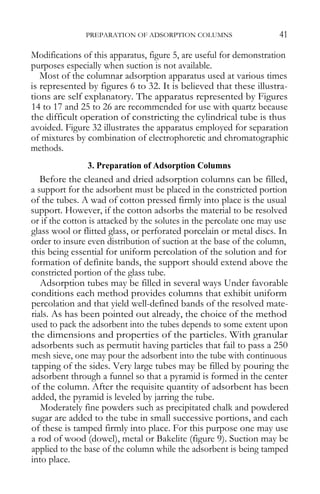


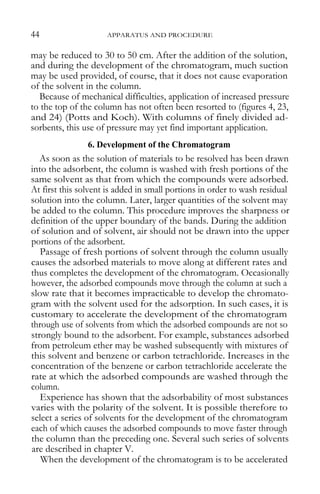























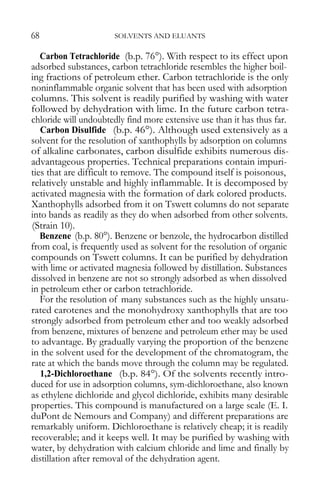







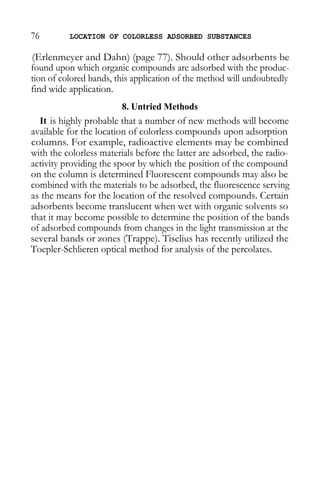


















































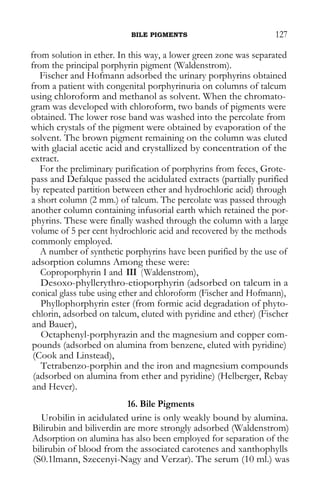














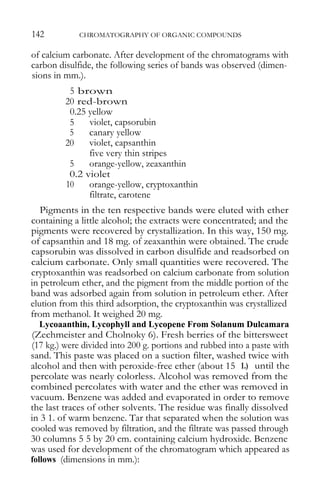
















![TANNINS 159
By this procedure, a colorless, tasteless, nontoxic, nonfluorescent percolate is obtained.
Lubricating oil is sometimes purified by filtration through adsorp- tive clays. The spent clay is reactivated by combustion of the con- taminants in special kilns that prevent sintering of the clay itself [Ind. Eng. Chem. News Ed., 19, 160 (1941)].
4. Sugar
One of the oldest applications of adsorption methods in industry is the decolorization of sucrose solutions obtained by extraction of plant material. The plant extract or crystals of crude sugar are dissolved in water and this solution is passed through large towers filled with activated charcoal. Channeling or uneven percolation is prevented by uniform distribution of the adsorbent in the tower. Usually the dry charcoal is distributed layer upon layer with a rotat- ing mechanical spreader. Revivification of the spent charcoal by burning makes possible its reuse.
In laboratory tests, activated bauxite has been found as efficient as bone char for the purification of sugar solutions (La Lande). The experiments were performed in steel columns with hot water jackets. At 68° the alumina removed both invert sugar and the inorganic contaminants. Spent alumina was revivified by elution with water followed by dehydration at 315 -485° for 0.5 hour. On repeated use and reactivation, the capacity for adsorption of inorganic compounds was scarcely impaired.
5. Tannins
The source and the nature of tannins used for production of leather from hides have been determined by adsorption of the tannins them- selves or by adsorption of extracts of the leather. Grassmann and also Grassmann and Lang added two parts by volume of methanol to concentrated aqueous solutions of tannins and adsorbed the mix- ture on alumina or magnesia. The columns were washed with ethyl acetate or with methanol and ethyl acetate (1:3), and observed in ultraviolet light.
Extracts of pine bark, oak wood and quebracho wood were ad- sorbed and compared. All of these yielded complex chromatograms with many fluorescent zones. The fluorescence varied with the pH of the solution, being more intense in acid than in alkaline solutions.](https://image.slidesharecdn.com/170108ouchromatographicadsorptionanalysis-141126163030-conversion-gate02/85/chromatographic-adsorption_analysis-175-320.jpg)





![BIBLIOGRAPHY 165
(3) The isolation of the antirachitic vitamin from tuna fish-liver
oil. Z. physiol. Chem., 241, 104 (1936).
(4) The isolation of antirachitic vitamin from halibut-liver oil.
Z. physiol. Chem., 245, 96 (1937).
(5) Chromatographic adsorption. Angew. Chem., 53, 384 (1940).
BROCKMANN, H. and A. BussE: The antirachitic vitamin of blue fin tuna- liver oil. Z. physiol. Chem., 249, 176 (1937).
BROCKMANN, H. AND R. HAASE: (1) Dracorubin, the red pigment of 'dragon's blood." I. Ber., 69, 1950 (1936).
(2) Dracorubin, II. Ber., 70, 1733 (1937).
BROCKMANN, H. and K. MAIER. Rottlerin. Ann., 535, 149 (1938). BROCKMANN, H., and H. SCHODDER : Aluminum oxide of graduated adsorp-
tion capacity for chromatographic adsorption. Ber., 74, 73 (1941). BROCKMANN, H. and M. L. TECKLENBURG The vitamin A content of rat
liver after feeding a-, 0- and 7-carotene, and the antimony trichloride
reaction of vitamin A preparations Z. physiol. Chem., 221, 117 (1933). BROCKMANN, H. and 0. VOLKER. The yellow pigment of the canary [Serinus
canaria canaria (L.)] and the occurrence of carotenoids in birds. Z.
physiol. Chem., 224, 193 (1934).
BROWN, W. G.. Micro separations by chromatographic adsorption on blot- ting paper. Nature, 143, 377 (1939).
BRUCE, W. F. and L F. PIESER • Carcinogenic hydrocarbons. I. 15,20- Dimethylcholanthrene. J. Am. Chem. Soc., 69, 479 (1937).
BRUNAUER, S., L. S. DEMING, W. E. DEMING, and E. TELLER: A theory of
the van der Waals adsorption of gases. J. Am. Chem. Soc., 62, 1723 (1940).
BRUNNER, 0.: The pigment of the retina. Oesterr. Chem.-Zig., 40, 203 (1937).
BRUNNER, 0. and E. BARONI Retinal substances. IV. The flavins of the retina. 211 onatsh , 68, 264 (1936).
BRUNNER, 0., E. BARONI and W. KLEINAU: Visual purple. Z. physiol. Chem., 236, 257 (1935).
BRUNNER, 0. and R. STEIN: The carotenoids of Rana esculenta. Biochem. Z., 282, 47 (1935).
BUNNING, E.• (1) Phototropism and carotenoids. I. Phototropic activity of light of various wave lengths and light absorption by the pigment of Pflobolus. Planta, 26, 719 (1937).
(2) Phototropism and carotenoids. II. The carotene of the sensi-
tive absorption regions of Pilobolus, Phycomyces and Avena. Planta, 27, 148 (1937).
Buxix, W. N. and I. K. MURRI: Chemical methods for determining vitamins (carotene). Bull. Applied Botany, Genetics Plant Breeding U.S.S.R. (Ser. III), No. 11, 27 (1935).
BURKHARDT, G. N., I. M. HEILBRON, H. JACKSON, E. G. PARRY and J. A.](https://image.slidesharecdn.com/170108ouchromatographicadsorptionanalysis-141126163030-conversion-gate02/85/chromatographic-adsorption_analysis-181-320.jpg)







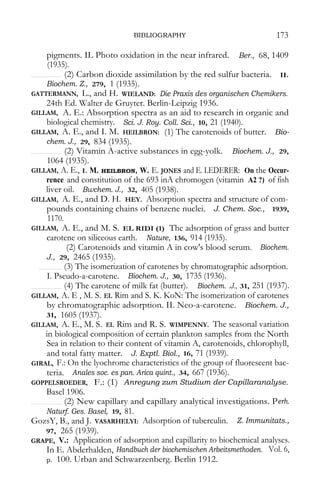







![BIBLIOGRAPHY 181
(10) Semi-a-carotenon; a procedure for the accomplishment of
chemical reactions. Ber., 66, 1319 (1933).
(11) The structure of a-carotene, Ber., 67, 885 (1934).
(12) On a-oxy-carotene. Ber., 67, 1408 (1934).
(13) On the stepwise degradation and the structure of a-carotene.
Ann., 516, 95 (1935).
KITHN, R., H. BROCKMANN, A. SCHEUNERT and M. SCHIEBLICH . Growth stim- ulation by carotenes and xanthophylls. Z. physiol. Chem., 221, 129 (1933).
KUHN, R., and A. DANSI: Molecular rearrangement of N-glucosides. Ber., 69, 1745 (1936).
KUHN, R., P. DESNUELLE and F. WEYGAND: On the specificity of lacto- flavin; the significance of the position of the methyl group. Ber., 70, 1293 (1937).
KUHN, R., and A. DEUTSCH. The structure of azafrin. Ber., 66, 883 (1933). KUHN R., and C. GRUNDMANN: (1) The structure of lycopene. Ber. 65, 1880 (1932).
(2) The first oxidation products of lycopene. Ber., 65, 898
(1932).
(3) Cryptoxanthin, a xanthophyll of the formula C4011260. (On
the growth vitamin, V). Ber., 66, 1746 (1933).
(4) Rubixanthin, a new xanthophyll of the formula CoH660.
Ber., 67, 339 (1934).
(5) Cryptoxanthin from yellow corn. (On the growth vitamin,
VI). Ber., 67, 593 (1934).
(6) On the steric series of xanthophylls. Ber. 67, 596 (1934).
(7) A new way to synthesize polyenes, synthesis of hexatriene-1 , 6-
and octatetraene-1 ,8-dicarbonic acid. Ber., 69, 1757 (1936).
(8) Synthesis of des-crocetin (tetradecaheptaene-[1,3,5,7,9,11,13]- dicarbonic acid-11,141). Ber., 70, 1318 (1937).
(9) Synthesis of 1 ,6-dimethyl-hexatriene, 1 ,8-dimethyl-octate-
traene and 1 ,12-dimethyl-dodecahexaene. Ber, 71, 442 (1938). KUHN, R., P. GYORGY and T. WAGNER-JAUREGG (1) On a new group of natural pigments. Ber., 66, 317 (1933).
(2) On ovoflavin, the pigment of eggwhite. Ber , 66, 576 (1933).
(3) On lactoflavin, the pigment of whey. Ber., 66, 1034 (1933).
KUHN, R., and H. KALTSCHMIrr: Isolation of lactoflavin (vitamin 132) from hay. Ber., 68, 128 (1935).
Kull/sr, R , and E. LEDERER. (1) Resolution of carotene into its components (on the growth vitamin, I.). Ber., 64, 1349 (1931).
(2) Taraxanthin, a new xanthophyll with four atoms of oxygen.
Z. physiol. Chem., 200, 108 (1931).
(3) On a- and a-carotene. Z. physiol. chem., 200, 246 (1931).](https://image.slidesharecdn.com/170108ouchromatographicadsorptionanalysis-141126163030-conversion-gate02/85/chromatographic-adsorption_analysis-197-320.jpg)















![BIBLIOGRAPHY 197
VALENTIN, H., and R. FRANCK: (1) Chromatographic adsorption analysis in pharmacy II. Determination of the cantharidin content in its tincture. Pharm. Ztg., 81, 943 (1936).
VEEN, A. G. VAN, and J. C. LANZING: Analysis of provitamin A in blood serum. Proc. Acad. Sci. Amsterdam, 40, 779 (1937).
VEGEZZI, G.: Investigations on some pigments of invertebrates: helicorubin, hepatochlorophyll, tetronerythrin. Ass. Fribourg. 1916.
VERMAST, P. G. F.: The carotenoids of Citrus aurantium. Naturwissen- schaften, 19, 442 (1931).
VERNE, J.: Les pigments dans l'organisme animal. Doin et Cie. Paris (1926). VOLKER, 0.: On the yellow feather pigment of (Melopsittacus undulatus [Shaw] ). J. Ornithol., 84, 618 (1936).
WAGNER, K. H. Vitamin A and 0-carotene of the 95 fin, blue and sperm
whales. Joh. Ambrosius Barth. Leipsig. (1939).
WAGNER-JAUREGG, T.• (1) The acridine salts of adenosine polyphosphoric acids. Z. physiol. Chem., 239, 188 (1936).
--- (2) The fatty acids of the tubercle bacillus. Z. physiol. Chem. 247, 135 (1937).
WAGNER-JAUREGG, T., and H. ARNOLD. Syntheses with aliphatic monoter- penes. Ann. 529, 274 (1937).
WALD, G.: Pigments of the retina. I. The bullfrog. J. Gen. Physiol., 19, 781 (1936).
WALD, G., and H. ZUSSMANN: Carotenoids of the chicken retina. J. Biol. Chem., 122, 449 (1938).
WALDENSTROM, J.. (1) Investigations on urinary pigments, principally porphyrins, by means of chromatographic analysis. Deut. Arch. klin. Med., 178, 38 (1935), Z. physiol. Chem., 239, III (1936).
(2) Porphyria. Acta Med. Scand. Suppl. 82, 3 (1937).
WALKER, 0.: I. Review on the chemistry of the carotenoids and their dis- tribution in nature. II. Investigations on carotenoids. Inaugural- Dissertation Zurich. 1935.
WALTER, E. D., M. L. WOLFROM and W. W. HEss. A yellow pigment from the osage orange (Maclura pomifera Raf.). J. Am. Chem. Soc., 60, 574 (1938).
WEITZ, E., and F. SCHMIDT: On the appearance of colors upon adsorption on surface active materials; analogy between the action of adsorption and of complex formation, Ber., 72, 1740 (1939).
WEITZ, E., and F. SCHMIDT: Polarization and color change upon adsorption on surface active materials. II. Ber., 72, 2099 (1939).
WETTER, F., and K. DIMROTH: On the preparation of a homolog of epi- coprosterol in the ergosterol series. Ber., 70, 1665 (1937).
WETTSTEIN, A.: On steroids. (24). On .6,4,6-3-ketones of the androstane and pregnane series. Hely. Chim. Acta, 23, 388 (1940).](https://image.slidesharecdn.com/170108ouchromatographicadsorptionanalysis-141126163030-conversion-gate02/85/chromatographic-adsorption_analysis-213-320.jpg)
![198 BIBLIOGRAPHY
WarrEEDDEN, J. C.: A chemical method for estimating epinephrine in blood. J. Biol. Chem., 108, 633 (1934).
"Permutit" as a reagent for amines. J. Biol. Chem., 56, 751 (1923).
WIELAND, H., A. HARTMANN and H. DIETRICH: Quinovaic acid. Ann., 522, 191 (1936).
WIELAND, H., G. HESSE and R. HtrrEL: Toad poisons. IX. Further con-
siderations of constitutional problems. Ann., 524, 203 (1936). WIELAND, H., and L. HORNER: Structure of vomicine. Degradation of
vomicidine. On strychnine alkaloids. XVIII. Ann., 528, 73 (1937). WIELAND, H., and Y. KANAOKA: Secondary sterols of yeast. V. Zymo-
sterol and ascosterol. Ann., 630, 146 (1937).
WIELAND, H., W. KONZ and R. SONDERHOFF: On cuarin from calabash curare. Ann., 527, 160 (1937).
WIELAND, H., and A. KOTZSCHMAR: Wing pigments of the common white butterfly. III. Ann., 530, 152 (1937).
WIELAND, H., K. KRAUS, H. KELLER and H. OTTAWA: Investigations on the constitution of bile acids (LIV). On some unsaturated bile acids. Z. physiol. Chem., 241, 47 (1936).
WIELAND, H., H. PASEDACH and A. BALLAUF. Secondary sterols of yeast. IV. Cryptosterol. Ann., 529, 68 (1937).
WIELAND, H., T. PLOETZ and H. INDEST. Occurrence of free radicals in
chemical reactions. IX. Ann., 532, 166 (1937).
WIELAND, H., and 0. PROBST. Some reactions of biphenylene-ethylene. Studies in the fluorene series. IV. Ann., 530, 274 (1937).
WIELAND, H., and It. PURMANN Wing pigments of the common white but- terfly. VI. The relation between xanthopterin and leucopterin. Ann., 539, 179 (1939).
WIELAND, H., and C. SCHOPF: Yellow wing pigment of the brimstone butter- fly (Gonepteryx rhamni). Ber., 58, 2178 (1925).
WIJNGAARDEN, J. C. H. VAN: Carotene, vitamin A and vitamin C in cows milk. Dissertation Utrecht 1935.
WILLSTAEDT, H.. (1) Carotinoide, Bakterien- and Pilzfarbstoffe. Ferdinand
Enke. Stuttgart 1934.
(2) Astacene from the shell of the lobster (Potamobius [Astacus]
Svensk Kern. Tids., 46, 205, 261 (1934).
(3) On chromatographic analysis and its applications. Svensk
Kern. Tids., 48, 32 (1936).
(4) The pigments in the fruit of Rosa rugosa Thunb. Svensk Kern.
Tids., 47, 112 (1935).
(5) The pigments of the true orange agaric (Lactarius deliciosus L.).
Ber., 68, 333 (1935); II., 69, 997 (1936).
(6) The vitamins. Their chemistry and biochemistry. Klin.
Wochschr., 14, 841, 1085 (1935); 15, 1505 (1936).](https://image.slidesharecdn.com/170108ouchromatographicadsorptionanalysis-141126163030-conversion-gate02/85/chromatographic-adsorption_analysis-214-320.jpg)






















![SUBJECT INDEX 221
Siliceous earth, 109
She Hyflo Super Cel
Silicic acid, 50, 85, 86, 87, 89, 94, 96,
112, 175
Silver ion, 79, 80, 81 Sitosterol, 98, 99
Snake venom, 195 Soda ash
see Sodium carbonate Sodium carbonate, 50, 132
Solanum dulcamara, 133, 137, 142 Solutions, 43
Solvents, 50, 65
polarity of, 44
properties of, 67 purification of, 67 selection of, 29, 44, 53 Spatulas, 46
Sucrose, 50, 62, 121, 123, 124, 125 Sugars, 49, 89, 188
Spirillum rubrum, 136 Spirilloxanthin, 136 Spirit-eosin, 150
Starch, 50, 121, 186 Stearic acid, 6, 85, 86
Steroids, 169, 175, 185, 186, 189, 197 Sterols, 19, 20, 97, 167, 176, 183, 189,
198, 203
Sterol hydrocarbon, 175 Stigmasterol, 20, 99, 170 Stilbene, 23
Strophanthii tincture, 160 Strophanthus, 100 Suction, 43
Sudan III, 105, 158 Sudan yellow, 55 Sulcatoxanthin, 135 Sulfate ion, 82
Sulfide ion, 82
Sunflower oil, 158, 188 Squalene, 194
T
Tagetes aurea, 148
Talc, 49, 50, 60, 74, 87, 91, 121, 125, 128 Tannins, 159, 162, 173
Taraxanthin, 27, 136, 181, 182 Tartaric acid, 162
Tautomerism, 153
Taxus baccata, 137 Terpenes, 90
Testosterone, 168, 189 Tetrabenzo-porphin, 127 Thallium ion, 79
Thebain, 101, 102
Thiocystis bacteria, 125 Three column test, 12 Tincture Belladonnae, 161 Tincture Ipecacuanhe, 161 Tincture Strychni, 161
Titania, 49, 59, 89
Toad poisons, 100, 195, 198 Tocopherols, 106, 107, 164, 169, 170,
176,177, 178, 179, 192
Toluene, 66
Tomatoes, 133, 138 Torula rubra, 134 Torulene, 134
Toxiferin, 102
Triarylmethyl halides, 94 Trichloroethylene, 87 Trinitrobenzene, 153 Triolein, 87
Triphenylcarbinol, 94 Triphenylmethane, 94 Triterpenes, 189 Tritisterols, 98 Trypaflavin, 151 Trypsin, 115
Tuberculin, 115, 173 Tungstate ion, 77
II
Uranyl ion, 78, 79, 81
Urine, 110, 111, 112, 113, 118, 127, 175 Ultraviolet light, 71, 72, 73, 92, 95, 140, 160, 168
Ultra-chromatogram, 71, 72, 177, 178, 180
Unsaponifiables, 163, 169, 178 Urobilin, 127
Uroflavin, 110
Uropterin, 118, 119
V
Vanadate ion, 77
Vegetable oils, 158
Veratnne alkaloids, 167
Verona], 101
Vespa crabro, 119
Victoria blue B, 149, 151
Vinum condurango, 160 Violaxanthin, 27, 136, 182 Violaxanthin b, 144, 145 Viol-erythnn, 138
Visual purple, 165
Vitamin A, 75, 102, 103, 104, 164, 165,
166, 169, 170, 173, 174, 175, 176,
177,179, 182, 184, 187, 190, 198, 199, 201
Vitamin B,, 108, 109, 166, 174, 199, 203 Vitamin B2, 109, 110
Vitamin C, 111, 168, 177, 198 Vitamin D, 19, 72, 104, 105, 106, 165, 186
Vitamin E, 106,168, 169, 176, 177, 178, 179, 192, 195
see Tocopherols
Vitamin K1, 11, 59, 107, 164, 168, 170, 177,185](https://image.slidesharecdn.com/170108ouchromatographicadsorptionanalysis-141126163030-conversion-gate02/85/chromatographic-adsorption_analysis-237-320.jpg)





